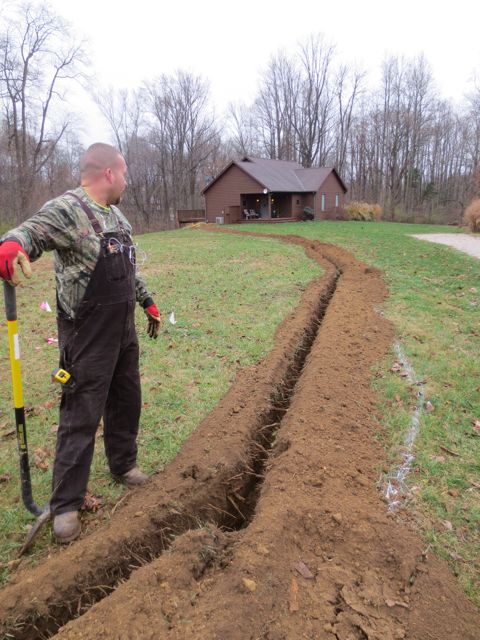After the concrete pad was completed the next step was to trench electrical, data and security cables to the observatory pad. Since the observatory is over 200 feet from the house trenching for the cables was a significant job. This was a bigger job than I wanted to tackle with a walk behind trencher. Therefore I hired an excellent electrical contractor to run the power and data connections to the observatory.
The day started out pretty nice. The weather forecast was predicting dropping temperatures with the possibility of light snow flurries. Our contractor got an early start, so we did not expect the weather to be a problem.
He used a Bobcat with a trenching attachment to dig the trench. The entire trench was completed in less than an hour. As you can see by his attire, the temperatures were not real cold when he completed the trench. Unfortunately, that was going to change!
By the time he started assembling the conduit, the we were starting to get light snow flurries.
The next step was pulling the cables. The snow flurries were getting progressively heavier as they were pulling the wires.
Before they were done the weather turned into near blizzard conditions. Note they are now wearing heavy coats and gloves. I stepped inside the house after this photo, to warm up. Of course, they kept on working!
By far the hardest part was pulling the three heavy gage wires through the power conduit. This is where the skill of the electrician versus the weekend warrior (home DIY) is apparent. Even with the atrocious weather, they were able to get the wire pulled and the conduit into the trench in a little less than two hours. The biggest problem they had was maintaining their footing in the slippery slope near the house.
Once all the wires and conduits was in the ground everyone was chilled to the bone. So much for trusting the weather forecast.
Some final comments on this part of the project.
- Install large power and data conduits.
The electrician that everything be installed in conduits; even though it was not required by our local code. He would have had to bury the wires deeper had he not used conduit. Also, he inserted a pull string in each conduit, in case we would ever need to add an additional circuit or data cable someday. This is very cheap insurance. - Install larger circuits than you think you need.
I asked for two 15A circuits. I felt this was enough capacity to satisfy my requirements. However, he suggested two 30A circuits and an additional wire to give me 230V circuit if needed. The difference in cost was only about $300. In retrospect, I realize that two 15A circuits would have been marginal since one them was already dedicated to the Roll-off-Roof system. That would have left a single 15A circuit to power everything else in the observatory. With the 60A capacity I have, I don’t have to worry about future growth. - Utilize an experienced, licensed electrician.
Their experience and skills will save you money and problems in the long run. My electrician saved me a lot of frustration and kept me from making several costly mistakes. I also ended up with a much better installation than I could have done myself.
Fred




